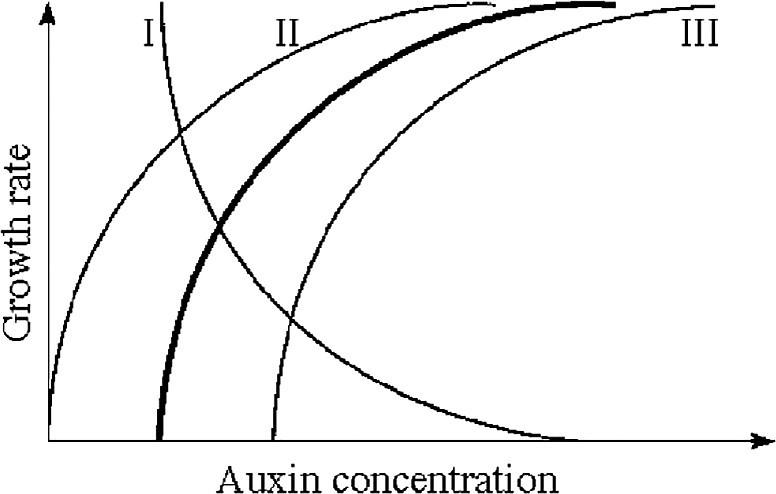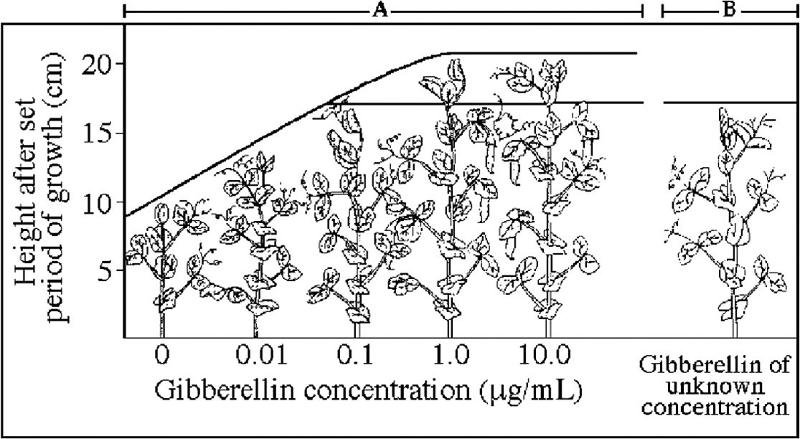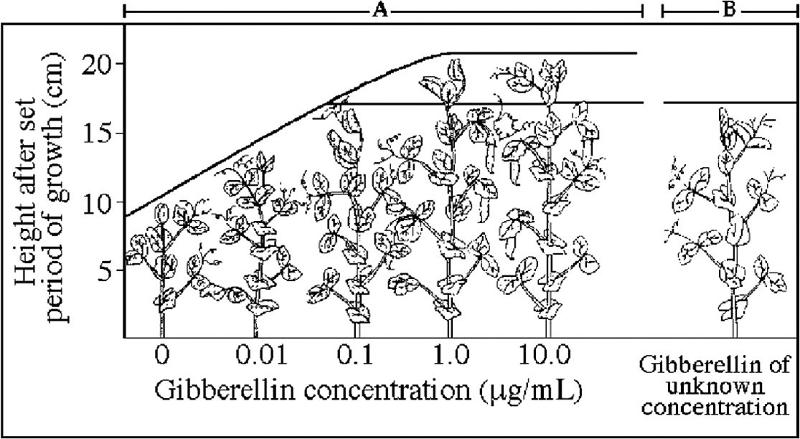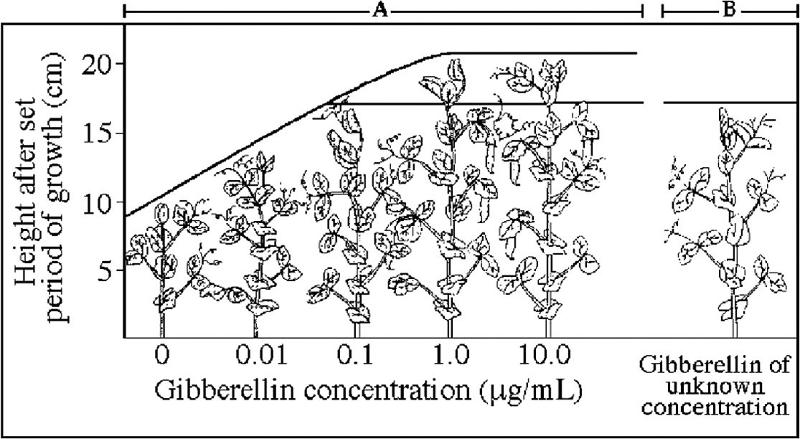Almost all plant cells have the ability to produce abscisic acid. One of the functions of abscisic acid in plants is to
- A) stimulate cell elongation.
- B) regulate development of fruit.
- C) promote stomatal closure during drought stress.
- D) delay leaf senescence.
C
Charles and Francis Darwin concluded from their experiments on phototropism by grass seedlings that the part of the seedling that detects the direction of light is the
- A) tip of the coleoptile.
- B) part of the coleoptile that bends during the response.
- C) base of the coleoptile.
- D) cotyledon.
A
Which of the following conclusions is supported by the research of both Frits Went and Charles and Francis Darwin on shoot responses to light?
- A) When shoots are exposed to light, a chemical substance migrates toward the light.
- B) Agar contains a chemical substance that mimics a plant hormone.
- C) A chemical substance involved in shoot bending is produced in shoot tips.
- D) Once shoot tips have been cut, normal growth cannot be induced.
C
A plant seedling bends toward sunlight because
- A) auxin migrates to the lower part of the stem due to gravity.
- B) there is more auxin on the light side of the stem.
- C) auxin is destroyed more quickly on the dark side of the stem.
- D) auxin is found in greatest abundance on the dark side of the stem.
D
The apical bud of a shoot produces ________, resulting in the inhibition of lateral bud growth.
- A) abscisic acid
- B) ethylene
- C) cytokinin
- D) auxin
D
After some time, the tip of a plant that has been forced into a horizontal position grows upward. This phenomenon is related to
- A) calcium release from the endoplasmic reticulum of shaded cells.
- B) whether the plant is in the northern or southern hemisphere.
- C) auxin production in cells receiving red light.
- D) auxin movement toward the lower side of the stem.
D
The ripening of fruit and the dropping of leaves and fruit are principally controlled by
- A) auxins.
- B) cytokinins.
- C) indoleacetic acid (IAA).
- D) ethylene.
D
The plant hormone involved in stimulation of stem elongation is
- A) auxin.
- B) ethylene.
- C) florigen.
- D) abscisic acid.
A
When growing plants in culture, IAA is used to stimulate cell enlargement. Which plant growth regulator has to now be added to stimulate cell division?
- A) ethylene
- B) indoleacetic acid
- C) gibberellin
- D) cytokinin
D
Why do coleoptiles grow toward light?
- A) Auxin is destroyed by light.
- B) Gibberellins are destroyed by light.
- C) Auxin synthesis is stimulated in the dark.
- D) Auxin moves away from the light to the shady side.
D
Which of the following statements applies to plant growth regulators?
- A) They only act by altering gene expression.
- B) They often have a multiplicity of effects.
- C) They function independently of other hormones.
- D) They affect the division and elongation, but not the differentiation, of cells.
B
Plant hormones produce their effects by
- A) altering the expression of genes.
- B) modifying the structure of the hormones.
- C) modifying the structure of the nuclear envelope membrane.
- D) altering the expression of genes and modifying the permeability of the plasma membrane.
D
Plant hormones can have different effects at different concentrations. This explains how
- A) some plants are long-day plants and others are short-day plants.
- B) signal transduction pathways in plants are different from those in animals.
- C) plant genes recognize pathogen genes.
- D) auxin can stimulate cell elongation in apical meristems, yet will inhibit the growth of axillary buds.
D
Which part of plant structure synthesizes cytokinins primarily?
- A) shoot apical meristem
- B) roots
- C) ripened fruits
- D) almost all plant parts
B
How does indoleacetic acid affect fruit development?
- A) by preventing pollination
- B) by inhibiting formation of the ovule
- C) by promoting gene expression in cambial tissue
- D) by promoting rapid growth of the ovary
D
If a farmer wanted more loosely packed clusters of grapes, he would most likely spray the immature bunches with
- A) auxin.
- B) gibberellins.
- C) cytokinins.
- D) ethylene.
B
Which of the following statements best summarizes the acid growth hypothesis in an actively growing shoot?
- A) Auxin stimulates proton pumps in the plasma membrane and tonoplast.
- B) Auxin-activated proton pumps lower the pH of the cell wall, which breaks bonds and makes the walls more flexible.
- C) Auxins and gibberellins together act as a lubricant to help stretch cellulose microfibrils.
D) Auxins activate aquaporins that increase turgor pressure in the cells
B
According to the acid growth hypothesis, auxin works by
- A) dissolving sieve plates, permitting more rapid transport of nutrients.
- B) dissolving the cell membranes temporarily, permitting cells that were on the verge of dividing to divide more rapidly.
- C) changing the pH within the cell, which would permit the electron transport chain to operate more efficiently.
- D) increasing wall plasticity and allowing the affected cell walls to elongate.
D
Which of the following hormones would be most useful in promoting the rooting of plant cuttings?
- A) strigolactones
- B) cytokinins
- C) gibberellins
- D) indolebutyric acid
D
The aleurone layer is stimulated to release ________ as a result of gibberellin release from the embryo.
- A) amino acids
- B) carbohydrates
- C) cytokinins
- D) amylase
D
If you were shipping green bananas to a supermarket thousands of miles away, which of the following chemicals would you want to eliminate from the plants' environment?
- A) CO2
- B) cytokinins
- C) ethylene
- D) auxin
C
Which of the following plant responses is primarily due to the action of gibberellins?
- A) cell division
- B) sex determination
- C) inhibits growth
- D) promotes ripening of many types of fruit
B
Experiments on the positive phototropic response of plants indicate that
- A) light destroys auxin.
- B) auxin moves down the plant apoplastically.
- C) auxin is synthesized in the area where the stem bends.
- D) auxin can move to the shady side of the stem.
D
Why are axillary buds often inhibited from growing even though a stem may be actively elongating?
- A) The cells of axillary buds respond differently to auxin than stem cells.
- B) Axillary buds are high in abscisic acid that prevents elongation.
- C) Axillary buds are low in gibberellins.
- D) Stem cells lack receptors for auxin.
A
The application of which of the following hormones would be a logical first choice in an attempt to produce normal growth in mutant dwarf plants?
- A) indoleacetic acid
- B) cytokinin
- C) gibberellin
- D) abscisic acid
C
Plant hormonal regulation differs from animal hormonal regulation in that
- A) there are no dedicated hormone-producing organs in plants as there are in animals.
- B) all production of hormones is local in plants with little long-distance transport.
- C) plants do not exhibit feedback mechanisms like animals.
D) only animal hormone concentrations are developmentally regulated
A
Young leaves and developing seeds are the prime sites for ________ synthesis.
- A) auxin
- B) gibberellin
- C) cytokinin
- D) ethylene
B
Which of the following best explains both the growth of a vine up the trunk of a tree and the directional growth of a houseplant toward a window?
- A) nastic movement
- B) taxic movement
- C) tropism response
- D) morphological response
C
The detector of light during de-etiolation (greening) of a tomato plant is
- A) carotenoids.
- B) xanthophylls.
- C) phytochrome.
- D) chlorophyll.
C
Seed packets give a recommended planting depth for the enclosed seeds. The most likely reason some seeds are to be covered with only ¼ inch of soil is that the
- A) seedlings do not produce a hypocotyl.
- B) seedlings do not have an etiolation response.
- C) seeds require light to germinate.
- D) seeds require a higher temperature to germinate.
C
A short-day plant will flower only when
- A) days are shorter than nights.
- B) days are shorter than a certain critical value.
- C) nights are shorter than a certain critical value.
- D) nights are longer than a certain critical value.
D
A flash of red light followed by a flash of far-red light given during the middle of the night to a short-day plant will likely
- A) cause increased flower production.
- B) have no effect upon flowering.
- C) inhibit flowering.
- D) stimulate flowering.
B
Many plants flower in response to day-length cues. Which of the following statements best summarizes this phenomenon?
- A) As a rule, short-day plants flower in the summer.
- B) As a rule, long-day plants flower in the spring or fall.
- C) Long-day plants flower in response to long days, not short nights.
- D) Flowering in short-day and long-day plants is controlled by phytochrome.
D
Which of the following treatments would enhance the level of the Pfr form of phytochrome?
- A) exposure to far-red light
- B) exposure to red light
- C) long dark period
- D) inhibition of protein synthesis
B
In legumes, it has been shown that "sleep" movements are correlated with
- A) positive thigmotropisms.
- B) rhythmic opening and closing of K+channels in motor cell membranes.
- C) senescence (the aging process in plants).
- D) flowering and fruit development.
B
Statoliths are structures that are responsible for
- A) phototropism.
- B) gravitropism.
- C) thigmotropism.
- D) dormancy.
B
The biological clock controlling circadian rhythms must ultimately
- A) depend on environmental cues.
- B) affect gene transcription.
- C) stabilize on a 24-hour cycle.
- D) speed up or slow down with increasing or decreasing temperature.
B
Plants often use changes in day length (photoperiod) to trigger events such as dormancy and flowering. It is logical that plants have evolved this mechanism because photoperiod changes
- A) are more predictable than air temperature changes.
- B) alter the amount of energy available to the plant.
- C) are modified by soil temperature changes.
- D) can reset the biological clock.
A
________ promote(s) stomatal closure in plant leaves during drought stress.
- A) Auxins
- B) Cytokinins
- C) Gibberellins
- D) Abscisic acid
D
If the range of a species of plants expands to a higher latitude, which of the following processes is the most likely to be modified by natural selection?
- A) circadian rhythm
- B) photoperiodic response
- C) phototropic response
- D) biological clock
B
What does a short-day plant require in order to flower?
- A) a burst of red light in the middle of the night
- B) a burst of far-red light in the middle of the night
- C) a day that is longer than a certain length
- D) a night that is longer than a certain length
D
If a short-day plant has a critical night length of 15 hours, then which of the following 24-hour cycles will prevent flowering?
- A) 8 hours light/16 hours dark
- B) 4 hours light/20 hours dark
- C) 6 hours light/2 hours dark/light flash/16 hours dark
- D) 8 hours light/8 hours dark/light flash/8 hours dark
D
A long-day plant will flower if
- A) the duration of continuous light exceeds a critical length.
- B) the duration of continuous light is less than a critical length.
- C) the duration of continuous darkness exceeds a critical length.
- D) the duration of continuous darkness is less than a critical length.
D
Plants that have their flowering inhibited by being exposed to bright lights at night are
- A) day-neutral plants.
- B) short-night plants.
- C) short-day plants.
- D) long-day plants.
C
Classic experiments suggested that a floral stimulus, florigen, could move across a graft from an induced plant to a non-induced plant and trigger flowering. Recent evidence using Arabidopsis has shown that florigen is probably
- A) a phytochrome molecule that is activated by red light.
- B) a protein that is synthesized in leaves, travels to the shoot apical meristems, and initiates flowering.
- C) a membrane signal that travels through the symplast from leaves to buds.
- D) a second messenger that induces Ca2+to change membrane potential.
B
A short-day plant exposed to nights longer than the minimum for flowering but interrupted by short flashes of light
- A) will never flower.
- B) might flower depending upon the duration of the light flash.
- C) will not be affected and will flower.
- D) might flower depending upon the wavelengths of the light flashes.
D
A long-day plant will flower
- A) in the late fall.
- B) when the night is shorter than a critical value.
- C) only under artificial light in the summer.
- D) regardless of the photoperiod imposed.
B
You are part of a desert plant research team trying to discover crops that will be productive in arid climates. You discover a plant that produces a hormone under water-deficit conditions that triggers a suite of drought responses. Most likely the hormone is
- A) ABA.
- B) GA.
- C) IAA.
- D) 2,4-D.
A
What do the results of research on gravitropic responses of roots and stems show?
- A) Different tissues have the same response to auxin.
- B) The effect of a plant hormone can depend on the tissue.
- C) Some responses of plants require no hormones at all.
- D) Light is required for the gravitropic response.
B
A botanist discovers a plant that lacks the ability to form starch grains in root cells, yet the roots still grow downward. This evidence refutes the long-standing hypothesis that
- A) falling statoliths trigger gravitropism.
- B) starch accumulation triggers the negative phototropic response of roots.
- C) starch grains block the acid growth response in roots.
- D) starch is converted to auxin, which causes the downward bending in roots.
A
Most scientists agree that global warming is under way; thus, it is important to know how plants respond to heat stress. Which of the following would be a useful line of inquiry to try to improve plant response to and survival of heat stress?
- A) the production of heat-stable carbohydrates
- B) increased production of heat-shock proteins
- C) the opening of stomata to increase evaporational heat loss
- D) protoplast fusion experiments with xerophytic plants
B
In extremely cold regions, woody species may survive freezing temperatures by
- A) emptying water from the vacuoles to prevent freezing.
- B) decreasing the numbers of phospholipids in cell membranes.
- C) decreasing the fluidity of all cellular membranes.
- D) increasing cytoplasmic levels of specific solute concentrations, such as sugars.
D
The initial response of the root cells of a tomato plant watered with seawater would be to
- A) rapidly produce organic solutes in the cytoplasm.
- B) rapidly expand until the cells burst.
- C) begin to plasmolyze as water is lost.
- D) actively transport water from the cytoplasm into the vacuole.
C
The rapid leaf movements resulting from a response to touch (thigmotropism) primarily involve
- A) rapid growth response.
- B) potassium channels.
- C) nervous tissue.
- D) aquaporins.
B
Which of the following is the most likely plant response to an attack by herbivores?
- A) leaf abscission to prevent further loss
- B) early flowering to try to reproduce before being eaten
- C) production of chemical compounds for defense or to attract predators
- D) production of physical defenses, such as thorns
C
In order for a plant to initiate chemical responses to herbivory,
- A) the plant must be directly attacked by an herbivore.
- B) volatile "signal" compounds must be perceived.
- C) gene-for-gene recognition must occur.
- D) phytoalexins must be released.
B
The transduction pathway that activates systemic acquired resistance in plants is initially signaled by
- A) antisense RNA.
- B) Pfr
- C) salicylic acid.
- D) abscisic acid.
C
Which of the following would only be activated or upregulated after a plant has already been infected by a pathogen?
- A) phytochrome
- B) salicylic acid
- C) molecular chaperones
- D) stress proteins
B
A plant will recognize a pathogenic invader
- A) if it has many specific plant disease resistance (R) genes.
- B) when the pathogen has an R gene complementary to the plant's antivirulence (Avr) gene.
- C) only if the pathogen and the plant have the same R
- D) if it has the specific R gene that corresponds to the pathogen molecule encoded by an Avr
D
What is the probable role of salicylic acid in the defense responses of plants?
- A) to destroy pathogens directly
- B) to activate the systemic acquired resistance of plants
- C) to close stomata, thus preventing the entry of pathogens
- D) to activate heat-shock proteins
B
When an arborist prunes a limb off a valuable tree, he or she usually paints the cut surface. The primary purpose of the paint is to
- A) minimize water loss by evaporation from the cut surface.
- B) improve the appearance of the cut surface.
- C) stimulate growth of the cork cambium to "heal" the wound.
- D) block entry of pathogens through the wound.
D
When plants exhibit generalized defense responses in organs distant from the infection site, this is termed
- A) a hyperactive response.
- B) systemic acquired resistance.
- C) pleiotropy.
- D) hyperplasia.
B

The heavy line in Figure 31.1 illustrates the relationship between auxin concentration and cell growth in stem tissues. If the same range of concentrations were applied to lateral buds, what curve(s) would probably be produced?
- A) I
- B) II
- C) III
- D) II or III
A

The results of this experiment, shown on the left of the graph (area A), may be used to
- A) show that these plants can live without gibberellin.
- B) show that gibberellin is necessary in positive gravitropism.
- C) show that taller plants with more gibberellin produce fruit (pods).
- D) show a correlation between plant height and gibberellin concentration.
D

This experiment suggests that the unknown amount of gibberellin in the experimental plant (B) is approximately
- A) zero.
- B) 0.01 μg/mL.
- C) 0.1 μg/mL.
- D) 1.0 μg/mL.
C

This experiment suggests that the optimum amount of gibberellin in the experiment is approximately
- A) zero.
- B) 0.01 μg/mL.
- C) 0.1 μg/mL.
- D) 1.0 μg/mL.
D
In an experiment, a plant physiologist has four groups of bananas of the same species. He exposes each of the four groups of bananas with the same concentration of auxins, gibberellins, abscisic acid, or ethylene. Which of these four groups of bananas ripen the fastest?
- A) auxins
- B) gibberellins
- C) abscisic acid
- D) ethylene
D
In nature, poinsettias bloom in early March. Research has shown that the flowering process is triggered 3 months before blooming occurs. In order to make poinsettias bloom in December, florists change the length of the light/dark cycle in September. Given this information and clues, which of the following is a correct statement about poinsettias?
- A) They are short-day plants.
- B) They require a light period longer than some set minimum.
- C) They require a shorter dark period than is available in September.
- D) The dark period can be interrupted without affecting flowering.
A
A botanist exposed two groups of the same plant species to two photoperiods, one with 14 hours of light and 10 hours of dark and the other with 10 hours of light and 14 hours of dark. Under the first set of conditions, the plants flowered, but they failed to flower under the second set of conditions. Which of the following conclusions is consistent with these results?
- A) The critical night length is 14 hours.
- B) The plants are short-day plants.
- C) The critical day length is 10 hours.
- D) The plants flower in the late spring.
D
The hormone that helps plants respond to drought is
- A) auxin.
- B) abscisic acid.
- C) cytokinin.
- D) ethylene.
B
Auxin enhances cell elongation in all of these ways except
- A) increased uptake of solutes.
- B) gene activation.
- C) acid-induced denaturation of cell wall proteins.
- D) increased activity of plasma membrane proton pumps.
C
Charles and Francis Darwin discovered that
- A) red light is most effective in shoot phototropism.
- B) auxin can pass through agar.
- C) light destroys auxin.
- D) light is perceived by the tips of coleoptiles.
D
The signaling molecule for flowering might be released earlier than usual in a long-day plant exposed to flashes of
- A) far-red light during the night.
- B) red light during the night.
- C) far-red light during the day.
- D) red light during the day.
B
If a long-day plant has a critical night length of 9 hours, which 24-hour cycle would prevent flowering?
- A) 16 hours light/8 hours dark
- B) 14 hours light/10 hours dark
- C) 4 hours light/8 hours dark/4 hours light/8 hours dark
- D) 8 hours light/8 hours dark/light flash/8 hours dark
B
A plant mutant that showed normal gravitropic bending but did not store starch in its plastids would require a reevaluation of the role of ________ in gravitropism.
- A) auxin
- B) statoliths
- C) light
- D) differential growth
B